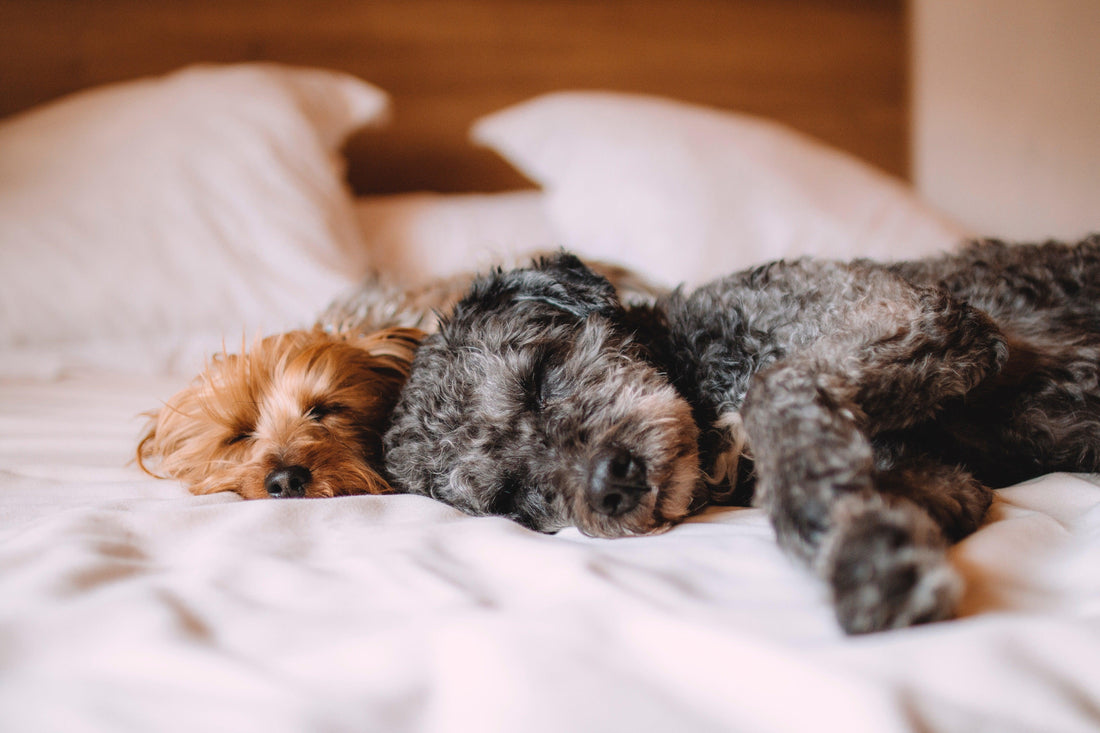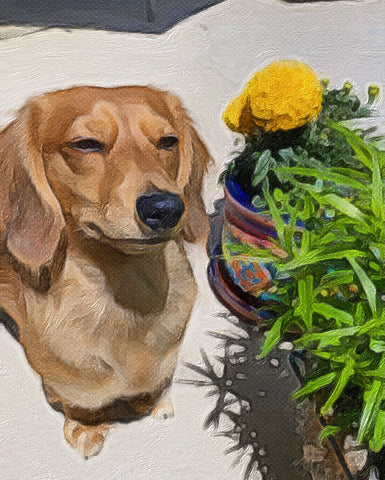
Ways to Turn Your Dog into a Painting
Share
It’s no secret that people love their dogs. Celebrities like Lady Gaga, Amanda Seyfried and Nick Jonas have entire Instagram pages dedicated to their pups. And now it looks like there’s a new trend on the rise: dog paintings!
Pet portraits are one of the best ways to honor the fuzziest member of your family, and they’ve become increasingly popular over the past few years. There are so many ways to turn your pup into a painting, with options for every price range and skill level.
How Do I Get A Painting Of My Dog?
You may be wondering where everybody is getting these gorgeous puppy paintings. Some people buy them, some people make them online, and some people paint them themselves. We’ve broken down all the ways to get or make a painting of your dog below, including pros and cons for each.
Commission One
Depending on your budget and your time frame, you could always commission a portrait of your dog from a professional artist. You’ll be sure to get a high-quality product that is customized to your unique vision.
The major drawback here is the price. There is a huge range of what you might be charged for a pet portrait, depending on where you look. Some artists charge anywhere from $50 to $100, while high-end, large portraits can cost anywhere from $2,000 to $10,000. Prices will vary depending on the style of the portrait, the level of detail, the materials used, and the experience level of the artist.
Another factor to consider here is the time frame. Custom portraits can take a long time to finish when you factor in the planning, the time it takes to complete, the drying process, and the shipping. If you’re looking to get a painting you can hang on your wall tomorrow, you may want to go a different route.
Make One Online
There are tons of ways to turn a photo of your pet into something that looks like a painting online, using software like Photoshop. Simply upload a photo of your pet, and some websites can make it look just like a painting. This is instant, and in most cases, free or very cheap.
Of course, these services don’t actually make a painting, just a digital photo that looks like a painting. Plus, you’d also have to pay to have it printed on a canvas.
Take A Class
There are a variety of places that offer pet portrait painting classes. These classes are usually taught by an artist who creates an outline for you, then teaches you to shade in that outline to create a realistic portrait of your pet.
Price is a definite factor here. Depending on where you go, it can cost anywhere from $50 to a few hundred. There also isn’t a ton of room for creativity here, as the outline is usually created for you.
Paint One Yourself
If none of the options above work for you, the best route might be to just paint one yourself. Thus can seem daunting, but there are a ton of online tutorials, tips, and tricks to help you paint an adorable portrait of your furry friend.
Painting the portrait yourself allows you full control over the style and the finished product and can be completed on your schedule. Plus, it’s fairly cheap. All you need to buy are the materials.
How To Paint Your Own Dog Portrait

Anybody can learn to paint a portrait of their dog, regardless of experience or skill level. Just remember to take it slow and do your research. Here are some tips to help beginners get started.
Choose Materials Wisely
If you’ve never painted before, make sure you choose materials that are easy to work with and beginner-friendly. We recommend using acrylic paint since it’s cheap, quick-drying, and easy to control. You’ll also want to pick up a variety of brushes so you can control your paint strokes and a smooth, flat canvas that isn’t too large, so you aren’t struggling trying to fill empty space.
Use a Reference Photo
It’s difficult to try to paint your pooch from memory, and getting a dog to sit still for hours to model for you is a tall order, even for the most obedient of breeds. Using a reference photo is a great way to make sure you’re getting their features and coloring right.
Have fun with this step, and make it into a mini photoshoot! Get your dog in as many poses as they’ll allow, so you can pick the angle they look the cutest at (let's be honest, they’re adorable from every angle).
Set Up Your Studio
Before sitting down to paint, make sure you’re choosing your workspace widely. You’ll want a large, flat surface where you can spread out your materials. You’ll also want to make sure the lighting is good, so you can see your work properly. Remember to cover your furniture with a drop cloth or newspaper to avoid stains. Don’t leave paints out where your dog can get them, as some paints can be toxic to dogs if ingested.
Graph It Out
One of the major struggles beginner artists have when it comes to painting portraits is realistic proportions. Each detail individually might look great, but when put together, they look all wonky. A great way to avoid this is to create two corresponding graphs, one on your reference photo and one on your canvas.
Draw lines on your reference photo going horizontally and vertically, all equally spaced, a few centimeters to a few inches between each, depending on the size of your reference. This will create equally sized squares to break up different areas of the painting. Label each square with a number and letter. For instance, in the first horizontal row, start with A1, then A2, then A3, and so on. In the next horizontal row, begin with B2, B3, and so on.
Now, repeat this process on a larger scale on your canvas, ensuring that you have the same number of squares. Now, you should have corresponding squares with labels on both your reference and your canvas. Each section of your reference photo should have the same amount of the image in the completed painting. If square A1 contains a small corner of your dog's ear in the reference, paint that in square A1 on your large canvas.
This helps to break up the work and ensure every section is in proportion to each other.
Start With a Sketch
When in doubt, sketch it out. Beginning with a pencil sketch takes the pressure off since you can always erase it and try again. Use the graphing method to help with the proportions, and once you have a sketch you’re happy with, begin the painting process.
Have Fun
Remember, at the end of the day, this is all for fun. Studies show that making art reduces stress and boosts mood, so let yourself relax and enjoy the process. If you don’t like the way your painting is coming out, you can always paint over the canvas with white paint and try again. So don’t take it too seriously. Put on your favorite relaxing music, and let the creativity flow.
Try a Paint By Numbers
If this still feels too overwhelming or beyond your skill level, order a custom paint by numbers kit from our site! Just upload a photo of your pet, and we’ll take care of the rest. The kit will arrive at your door with all the materials you need to create a customized, realistic pet portrait. All you need to do is fill in the sections.
Fun Portrait Ideas
Once you’ve mastered the art of the simple pet portrait, you can use these as additional inspiration to make your paintings extra fun.
- Paint your dog in Pop Art style
- Paint your dog in the style of your favorite cartoon
- Put your dog in a fancy outfit, like a tuxedo
- Paint your dog ding a human activity, like playing cards or riding a bike
- Put your dog in a fun location, like the beach, or Disney World
- Paint your dog as royalty
Conclusion
There are so many great ways to make your dog into a painting, but the best way is definitely to do it yourself! Even if you have no clue how to paint, it’s easy to teach yourself if you take it slow, sketch it out, and have fun with it. No matter what, you’ll end up with a beautiful tribute to how much you love your pup that you can hang on your wall for years to come.
If you liked this article, make sure to check out our website for more art inspiration, tips, and tricks, and shop our custom paint by numbers kits to create a perfect portrait every time.
Sources:
https://www.buzzfeed.com/ehisosifo1/pet-instagram-accounts-of-celebrities
https://vcahospitals.com/know-your-pet/paint-and-varnish-poison-alert-for-dogs-and-cats
https://drexel.edu/now/archive/2016/June/Art_Hormone_Levels_Lower/



